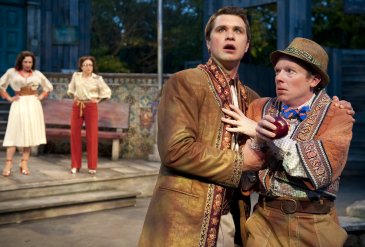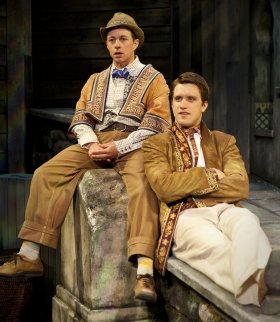Summary 
Outdoor production with brothers playing the Antipholus twins and a remarkably similar pair of performers portraying the two Dromios. Modernized to the 1930s and played as though a cross between a Hollywood action movie and a screwball pre-war comedy. Fast-paced, with colorful costumes and evocative movie-style music, and certainly an entertaining experience, although perhaps a bit too quick, with some continuity lost between the Hollywood adventure and movie comedy-romance themes.
Design
Directed by William Brown. Costumes by Devon Painter. Set by Kevin Depinet. Lights by Michael Peterson. Sound and original music by Andrew Hansen. Fights by Kevin Asselin.
Cast
James Ridge (Solinus), David Daniel (Egeon), Travis Knight (Jailor), Marcus Truschinski (Antipholus of Syracuse), Steve Haggard (Dromio of Syracuse), Andy Truschinksi (Antipholus of Ephesus), Darragh Kennan (Dromio of Ephesus), Carey Cannon (Adriana), Susan Shunk (Luciana), Tim Gittings (Balthazar/Dr Pinch), Matt Schwader (Angelo), Tiffany Scott (Courtesan), Sarah Day (Emelia).
Analysis
William Brown directs a modernized Comedy of Errors outdoors and "up the hill" at American Players Theatre (APT). The setting evokes 1930s Hollywood, and Brown begins with an Indiana Jones-like Egeon - clad in khakis and a blue dress shirt, boots, a faded brown bomber jacket, and the explorer's trademark Fedora - running across the stage with Moroccan police constables in hot pursuit. The agile Egeon, a leather bag strapped across his chest, leaps from a railing to the stage to avoid arrest but is eventually captured, his hands bound behind his back. Although Egeon frees his hands with Indy-like quickness from the ropes, he remains the prisoner of the prince, who sports a red fez and yellow braids across his official uniform, accompanied by the out-of-breath navy-blue uniformed constables as well as by a flexing leather-hooded headsman carrying an intimidatingly large broad-axe. The story somewhat clumsily segues from action-adventure to silly slapstick as Egeon recounts his wild shipwreck tale, and background music swells as the constables gather to hear the story, then ooh and aah with appreciation as Egeon shows them photographs of his family from an old leather wallet. Eloquent and dashing like an action movie star, Egeon charms the Ephesus police, who pass around the Fedora to collect cash donations for him.

The breathless chase recalls the frantic serial adventure of pre-World War II films and television, and Brown stages the Comedy in exotic northern Africa. A movie poster of Humphrey Bogart and Ingrid Bergman in Casablanca graces one upstage wall, and red Converse sneakers dangle by the shoelaces from an overhead power line. Overhead, advertising signs helpfully indicate stage areas, such as the Phoenix, the Abbess, and the Antipholus home. Soaring incidental Hollywood movie music - swinging horns and a jazzy beat - sometimes start and stop with comic suddenness as the farce slips quickly from scene to scene, and serve as rim-shot punctuation for punch-lines. The music certainly enhances the overall production, as do colorful and detailed costumes. Adriana, Luciana, and the Courtesan in particular are fabulously costumed, as attractive and sophisticated as 1930s Hollywood movie stars. Adriana and Luciana wear a white flashy dress and a chic pants suit, respectively, both in gleaming high-heels and curly late '30s/early '40s movie heroine hairstyles, and they strut and pose with wonderful flair, as if transported directly from a screwball Hollywood comedy. And the Courtesan, here an almost silent character, amuses with her struts and sachets across the stage, attracting attention with her silky and shimmering blue dress, and she pauses to flash some thigh while adjusting a heel, or leans way over to retrieve a handkerchief and wiggle her bottom for the benefit of her ogling admirers.
Real-life brothers anchor Brown's production, ably playing the separated Antipholus twins, the one from Ephesus frustrated with bouts of anger, the visitor from Syracuse confused and more than just a little fearful. Antipholus of Ephesus repeats an exuberant albeit anachronistic leaping high-five dance routine with his Arabic jeweler and merchant friends, and when he becomes enraged at the inexplicable antics of "his" servant Dromio, Balthazar calms him with a deep-tissue neck rub and scalp massage, then guides him through some deep-breathing exercises. Antipholus of Ephesus scratches his head and appears perplexed throughout, gaping in wonder at the odd merchants that dance and apparently expect a high-five from him, and he uses a squirming Dromio as a human shield against the advancing and catty Adriana. The incessant Three Stooges slapstick antics consistently amuse, despite some of the inherent lameness - a repeated "boing!" sound effect, some forced pratfalls - but some moments work well - during a heated duel with guards, one Antipholus is shocked to make a mortal stab with what turns out to be just a rubber sword - and Brown fuels the Hollywood screwball theme by inserting a pair of frantic musical interludes at the beginning of each act with the entire cast marching or scurrying across the stage in a kind of madcap parade of characters.

The Dromios - bearing an uncanny resemblance to one another in both appearance and demeanor, although not played by brothers - provide the production's most physical - and most comedic - moments. Dromio of Syracuse's description of the grotesquely spherical Nell is played as though a vaudeville comedy routine, and he hisses and claws the air like a cat to ward off the Courtesan. Both he and his counterpart play their parts with raw energy, literally sprinting through the play and breaking into spastic little fights. Brown pulls humor from the tiniest of moments, as when the Dromio from Ephesus literally spits the words, "Pinch's patient," as well as from the minor characters. Doctor Pinch is a big-haired, black-eyed witch doctor in heavy makeup, literally rolling bones to read the future; the merchant Angelo appears as though a Chinaman in his Fu Manchu mustache and wheeled cart of jewelry and souvenirs; and another exotic merchant, with evil-looking darkened eyes and long twisting fingernails, bares his chest for a wrestling duel.
Brown, emphasizing dizzying speed and the feather lightness of the entertainment, swiftly drives the production toward its close with the appearance of both sets of twins into spotlights, one far upstage and the other in the back of the theatre behind the seats. The audience twists and turns as the onstage characters gape and gasp in wonder. After the Prince fires a pistol to silence the crowd, the Antipholi take over, one sweeping Adriana off her feet for a dramatic movie kiss, and the other catching the leaping Luciana, as she wraps her legs around his waist and her arms around his neck. Pinch blows his horn and Indiana Jones-like Egeon, his adventure all but forgotten since the opening moments, finally is heard by the prince, and Brown concludes his spirited and colorful production.